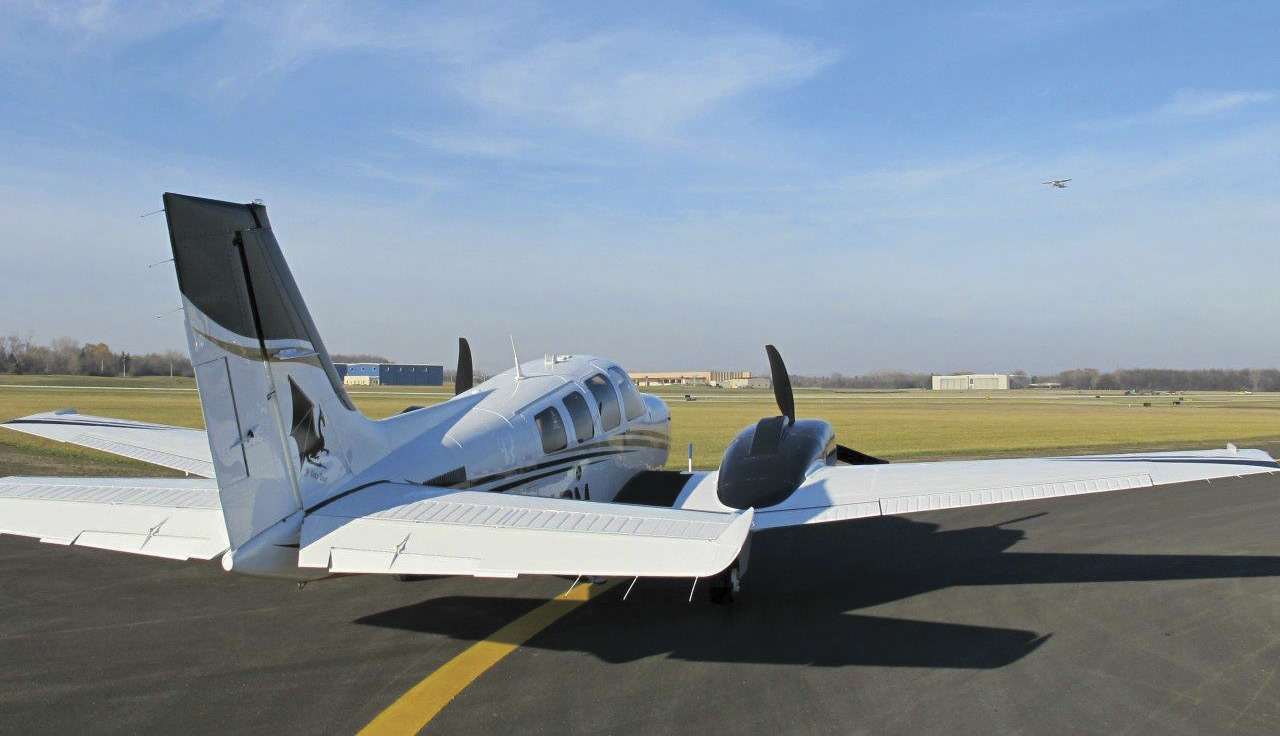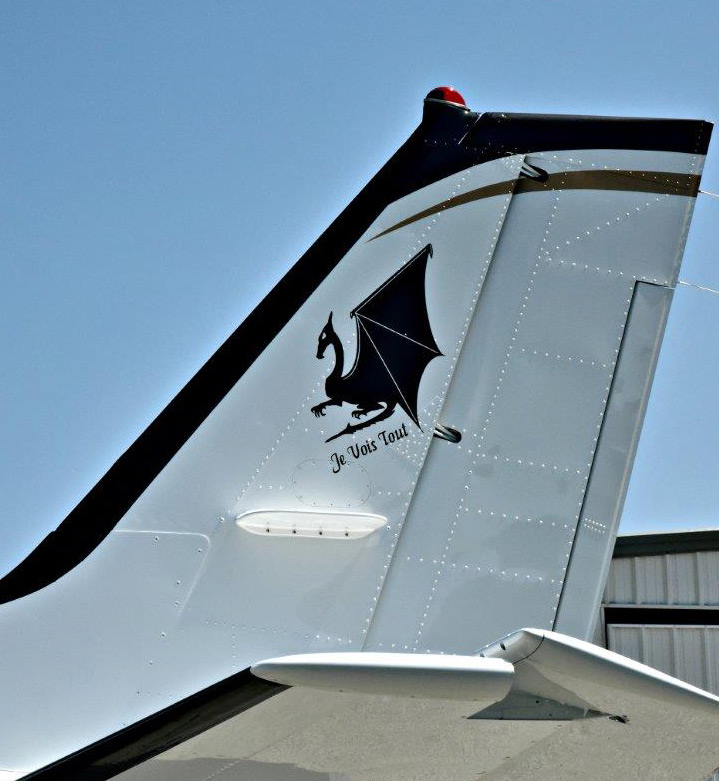↩ Back
Moving to multi-engine aircraft
Get more out of flying with advanced certification
There are several reasons single-engine pilots add multi-engine certifications to their licenses, and each reason generally lands in the "more" category: more speed, more room, more payload or more performance.
That's how two pilots ended up each owning their twin-engine aircraft. Don Deubler, an Illinois business owner, and Shailesh Kotwal, a Toronto banker, both wanted airplanes that were big enough for their families and fast enough to get them where they wanted to be when they wanted to be there.
Redundancy
As Kotwal researched the idea of moving from a single-engine rental to a multi-engine purchase, another benefit further convinced him to buy a multi-engine aircraft.
“As I dug more and more,” he said, “I realized the benefits of a twin-engine.”
Pilots often insist on redundancy when their flights take them over mountains or large bodies of water. Having an additional engine gives aviators the option to get to an airport or the most suitable landing place available. Some models include added engineering that keeps some or all systems—avionics, de-icing and even cabin comforts—running off the remaining single engine.
More speed, more space
While added confidence is an important reason to move to a multi-engine aircraft, other features often propel pilots in search of change, chief among them: speed and space. While Kotwal enjoyed the feeling of flying, his rental didn’t have room for his wife, two kids and all their luggage.
"Everybody in my family loves to travel, and I thought, 'Wouldn’t it be nice to get something bigger and yet within reach?'"Shailesh Kotwal, multi-engine-certified pilot
"I wanted something I could use, not only for my own pleasure, but also for family together time," he remembered.
While the added space is nice, Deubler’s bigger interest was the speed. The single-engine DA40 he owned before his Beechcraft® Baron® aircraft got him to one of his favorite places in about two hours, but he thought he could do better.
"I've got a cabin in the north woods, and instead of driving six and a half hours, I could be there in an hour and a half. That just gave me more time to fish for muskies."

Baron G58
1 hour 30 minutes
DA40
2 hours
Car
6 hours 30 minutes
The additional engine also provided the aircraft the added power to climb higher where more favorable winds could reduce fuel use and offer a smoother ride.
Quick, easy certification
Adding a multi-engine certification can be a relatively quick task—about a month for comprehensive training. It takes most pilots about ten to 15 flight hours to learn the skills necessary to pass a multi-engine check ride and oral exam, but many spend more time than that in class and in flight to learn skills that aren’t part of the test. They want to be prepared in case of any emergency.
That begins when choosing the right flight school.
"There is certain chemistry between the student and the instructor, said Deubler. "Find an instructor who can bring out the best qualities of a pilot in you."
When Deubler began looking for a strong flight school, he was lucky to have a good one close to home. The staff included a master instructor, and the owner is an FAA examiner. Deubler said he was quite prepared when, after two years of intermittent training, his instructor surprised him with the check ride.
"It was quite a gusty day, and I still passed. The examiner said I passed with flying colors, but I thought I was just OK. I try to hold my flying skills to a higher level than most."
Typical multi-engine pilots hold at least four* certifications:

Multi-engine
Single-engine
Instrument
Commercial
*Many turboprop pilots also choose to add the Airline Transport Pilot rating
Wanting even more in-depth training, both Deubler and Kotwal flew with mentor pilots after their checkrides to hone their experience as new multi-engine flyers. Even after Kotwal logged about 100 hours with his mentor pilot, he still planned to log some more since the twin was his first aircraft.

Expert advice
Insurance companies like to see at least 100 hours of flight time during the first year in a twin-engine aircraft.
"I fly maybe twice a month—if I’m lucky, three times a month," said Kotwal, "I’m not quite sure I will have the same level of proficiency as a professional pilot would. Plus, many a time it’s a busy day or a busy week, not enough time to plan, so it’s nice to have the comfort that, should something go wrong, there is somebody sitting beside me who knows better."
Multi-engine flight checklist
With the exception of a few multi-engine-specific items, most tasks included in the multi-engine Practical Test Standards (PTS) are the same or similar to the single-engine PTS requirements.
- Performance and Limitations
-
Preflight Preparation
-
Principles of Flight—Engine Inoperative
- Preflight Procedures
-
Preflight Inspection
-
Cockpit Management
-
Engine Starting
-
Taxiing
-
Runway Incursion Avoidance
-
Before Takeoff Check
- Takeoffs, Landings and Go-arounds
-
Normal and Crosswind Takeoff and Climb
-
Normal and Crosswind Approach and Landing
-
Short-Field Takeoff and Maximum Performance Climb
-
Short-Field Approach and Landing
- Performance Maneuver
-
Steep Turns
- Slow Flight and Stalls
-
Maneuvering During Slow Flight
-
Power-Off Stalls
-
Power-On Stalls
-
Spin Awareness
- Emergency Operations
-
Emergency Descents
-
Engine Failure During Takeoff Before VMC (Simulated)
-
Engine Failure During Takeoff Before VMC (Simulated)
-
Engine Failure After Lift-Off (Simulated)
-
Approach and Landing with an Inoperative Engine (Simulated)
-
Systems and Equipment Malfunctions
-
Emergency Equipment and Survival Gear
- Multi-engine Operations
-
Maneuvering with One Engine Inoperative
-
VMC Demonstration
-
Engine Failure during Flight (by Reference to Instruments)
-
Instrument Approach—One Engine Inoperative (by Reference to Instruments)
Operational costs
Before Deubler and Kotwal bought their twin-engine aircraft, they researched the operating costs and requirements. Kotwal’s research was more extensive because he’d never bought an aircraft before. He started talking to people, reading blogs and studying online manufacturer information.
"I didn’t know whether this was a traditional route people take—a new pilot jumping into a twin-engine," he said.
Once he knew he could afford the general costs of owning a twin-engine aircraft, he started looking for help with the buying process. He found it when he called the manufacturer.
"I did quite a bit of research on whether that was practical or not, and the more I read, the more I met with people, the more comfortable I got. It wasn’t an outlandish idea."Shailesh Kotwal, multi-engine-certified pilot
"Once I had kind of zeroed in on what the costs would be, I was much more concerned about being a new pilot. I wanted to have comfort that there is a reputable person and institution that I could reach out to that would guide me through lots of logistical issues that come into play," Kotwal said. "It was not only my first twin-engine, it was my first plane."
He says, for first-time buyers, receiving help with filing paperwork and completing other requirements before delivery is vital.
"For anybody who does this for pleasure or for hobby, they’ve presumably got a day-job that they’re occupied with, and working with these things is time-consuming."

Deubler enjoyed the process of earning his multi-engine certification, including taking delivery of his Beechcraft Baron G58 aircraft. Though he could have passed the check ride months before he finally did, he wanted more comprehensive training, explaining, “I think time and hours make you a better pilot.”
He suggests pilots do a gut-check before making the decision to buy.
"Over time, you kind of build an expectation of whether or not people are just giving you a sales pitch or they are being truthful," Kotwal said. "Cost was not a big driver once I knew what the ballpark was. It was all the administration, logistical issues, which swayed me."
Deubler had been through the buying process before, so he was prepared for the operational requirements. He says the overall differences in cost when flying a single-engine aircraft versus a twin-engine model are relatively minimal.
Ensuring insurability
Pilots who move up to a multi-engine aircraft often pay more in the beginning, but after a year or two the costs decrease. The reason: insurance. Greg Hiser, president of Air Capital Insurance in Wichita, Kansas, explained the initial cost increase, which depends on a pilot’s experience.
"If all your time’s been in a single-engine, fixed-gear aircraft, that’s not going to bode as well as if all your time’s been in a Bonanza® aircraft," Hiser said.

Just one look at the tail of Deubler’s Beechcraft Baron G58 aircraft shows how much fun he’s having in the air: a graphic inspired by the movie Eragon, a mythical story about a dragon flyer. Under it, a line from another movie, Flyboys—Je Vois Tout—French for “I see all.”
He said it's never too early to bring an insurance agent into the decision-making process, but make sure it’s someone who specializes in aviation.
"Being an active pilot myself, we look at where he’s been, what he’s flying now, what his experience level is, what he’s transitioning to. We will help him with a transitional plan that’s acceptable to an insurance company."
That plan often includes benchmarks that will help lower costs, including annual insurance premiums and mentor pilot fees when it’s time to take delivery of the aircraft. Some of those requirements may include a certain level of single-engine complex time and earning an instrument ticket. Hiser said it’s also a good idea for pilots to add commercial tickets to their licenses.
"It’s not required, but it shows another level of professionalism, and it’s an easy ticket to get,” said Hiser. “We want to do anything we can to make you look better in the eyes of an underwriter. If you’ve got a year or two to plan for that, all the better."
In most cases, underwriters will require new twin-engine piston pilots, even ones with experience with a complex single-engine aircraft, to log a minimum amount of time with mentor pilots—usually about 25 flight hours. Pilots who want to move directly from a non-complex, single-engine piston aircraft to a turboprop twin-engine airplane will likely need more than that.
Another factor transitioning pilots should consider is the new aircraft’s value. Hiser says premiums are largely based on the value of the aircraft so knowing which model a pilot wants to purchase is important for financial planning. The most important piece of advice Hiser offered: plan for at least 100 hours of flight time the first year in a twin-engine aircraft.
"Fly your aircraft for goodness sakes. A lot of them will buy the airplane, and then they don’t fly it a great deal. That doesn’t help," he said. "Buy the airplane. Fly it a fair amount so year number two, when we go to renew your policy, we can get your premiums down closer to where a comparable value for a single-engine airplane would be."
Both Kotwal and Deubler are often in the air these days. Deubler even graduated to a multi-engine turboprop, a Beechcraft King Air® C90GTx aircraft. Looking back on their multi-engine training, both said it was relatively easy.
Deubler’s advice, "Start with the basics, and learn to fly the plane. Build your foundation, and polish your skills with a quality instructor. Invest the time to develop your techniques to become an excellent pilot."
"Anybody thinking of going down this path, with adequate training and support, can certainly do so. It’s a very doable thing."Shailesh Kotwal, multi-engine-certified pilot
Kotwal’s analysis was similar, "I think this whole notion of flying a single-engine versus a twin isn’t as big a deal as I thought going in. It turned out not to be as complicated or as challenging."

Since earning his multi-engine rating, Don Deubler has continued to improve his skills as a pilot. More than two years after taking delivery of his Beechcraft Baron G58 plane, he traded up to a Beechcraft King Air C90GTx, a turboprop with increased performance.